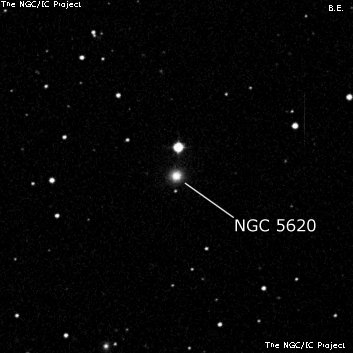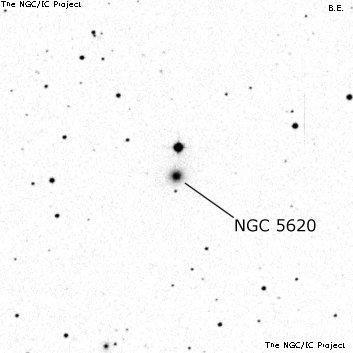NGC/IC Project Restoration Effort
(This is a very very beta version)
NGC5620


Basic Information
Location and Magnitude
Right Ascension: 14:22:40.5
Declination: +69:35:43
Constellation: UMI
Visual Magnitude: 14.1
Historic Information
Discoverer: Herschel W.
Year of discovery: 1785
Discovery aperture: 18.7
Observational
Summary description: eF, vS
Sub-type: E-S0
Corwin's Notes
=====
NGC 5620 is most likely = NGC 5607 (= IC 1005, which see for another story).
Steve Gottlieb brought this to my attention in early August 2007, questioning
the "standard" identification with CGCG 337-010. That ID is almost surely
wrong, the galaxy being 33 sec following and 2 degrees south of WH's place.
That would take it out of the range of WH's sweep, which -- given the evidence
of the galaxies he found that night -- was centered about a degree north of
27 Ursae Majoris.
WH found his object the night of 3 April 1785 placing it 32min, 2sec preceding
and 2deg 26arcmin south of beta UMi, the only object referred to this star on
that night. His brief description is "eF, not verified."
Reducing his offsets leads directly to the NGC position -- there is nothing
there (see the NGC Note copied from the GC for a source of some confusion not
carried over into the NGC). However, there is a faint galaxy (CGCG 337-009)
11 arcmin north, and NGC 5607 (= CGCG 337-007) is 2min 30sec preceding (both
are otherwise within WH's usual errors). The faint galaxy is flanked by
considerably brighter stars to the southwest and northeast; Steve suggests
that WH would have mentioned these if he had seen this galaxy. I tend to
agree. In addition to being more isolated, NGC 5607 is more than 1.5
magnitudes brighter, so is more likely to have stood out from the field and
been picked up in a sweep. WH indeed found it two weeks earlier on 16 March
1785 in another sweep; he got the position correct that time, and it became
NGC 5607.
But the magnitude difference is the only reason I can see for prefering the
brighter NGC object to the fainter CGCG. Both offsets from WH's position seem
to me to be equally likely (if anything, the implied single-digit error in
declination more so), and he has many other galaxies as faint as the CGCG in
his catalogues. Nevertheless, the brighter, isolated galaxy is compelling
enough that I've chosen to list it as the most probable of the two candidates.
Steve's Notes
=====
NGC 5620
See observing notes for NGC 5607. CGCG 337-010 is misidentified as NGC 5620 in the RNGC and PGC



